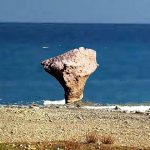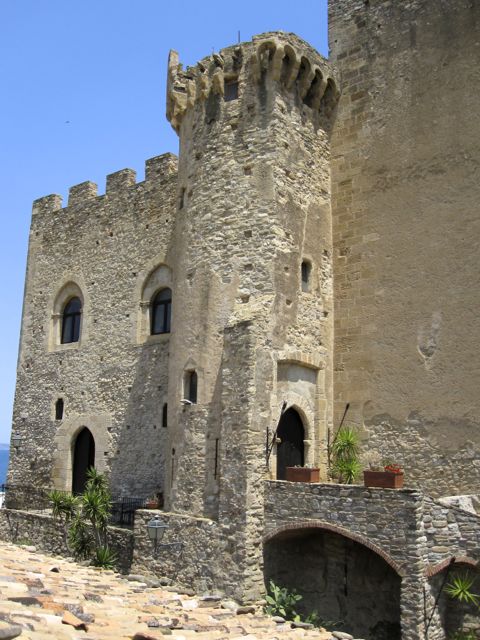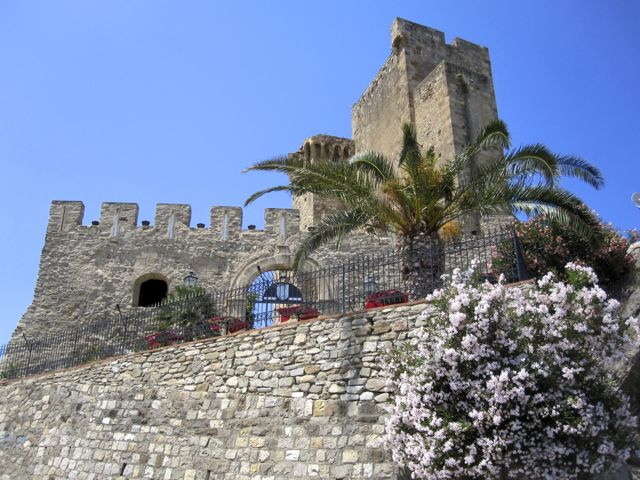The castle of Roseto Capo Spulico turns heads. Fused to a rocky cliff right at shore’s edge, the striking monument along the Ionian Sea is situated on the Calabrian side of the border between the southern Italian regions of Calabria and Basilicata. I had admired the majestic structure from train and bus windows before recently having the opportunity of viewing this Calabrian landmark up close and personal.

Castle Roseto Capo Spulico on state road 106 along Ionian coast
I was driving along state road 106 that flanks the Ionian coastline from Taranto to Reggio Calabria. Having shortly passed the town of Policoro in Basilicata, I was still musing on the area’s exceptional strawberries when before I knew it, the castle was upon me. With a simple left-hand turn I was in the parking lot and as my stomach had been letting me know it was time for lunch, I happily discovered there was also a restaurant on the premises.
THE ROSES AND BEACH OF ROSETO CAPO SPULICO

The Mushroom or Anvil Rock, Photo by Luigino~itwiki, Wikipedia Creative Commons
The designation Roseto Capo Spulico combines the town’s history with regard to roses and the name of the area’s cape. Interestingly, Roseto cultivated roses back from the time of Greater Greece. Legend has it that the petals were used to fill the mattresses of the well-to-do ladies in ancient Sybaris, a large city, just to the south, renowned for its self-indulgent lifestyle.
Perhaps Roseto was lucky with the roses, as it could just have easily been named after the large rock sticking out of the water near the shoreline. Commonly referred to as “il fungo del castello” (the castle’s mushroom), the anvil-shaped formation is a popular image often used to represent the area today.
This year, in addition to the backdrop of the castle and the mushroom, Roseto Capo Spulico beachgoers will also have the added cachet of lounging on one of Italy’s bandiere blu or blue flag beaches. This classification distinguishes beaches principally for the cleanliness of the water, but the criteria also encompass the zone’s ecological sustainability as well as the tourist services offered.

Roseto Capo Spulico Beach as seen from the castle
A LITTLE HISTORY OF THE CASTLE AT ROSETO CAPO SPULICO

Castle Entrance Roseto Capo Spulico
Before lunch, I decided to go for a walk around the castle. I thought I’d take a few photos of the outside, but the front door was wide open, so I went in and wandered around the many rooms and several floors of the former fortress, which appeared well set up for parties and receptions.

A Reception Hall in the Castle of Roseto Capo Spulico
Rooms with massive stone walls, arched ceilings and large fireplaces were adorned with decorative spears and the type of chandelier from which Errol Flynn would have enjoyed a good swing. The castle windows afforded stunning views of the beach and area surroundings, and admittedly, I wouldn’t have minded sipping a cocktail from one of the many terraces.

A Terrace at Castle Roseto Capo Spulico
Afterwards, on their brochure I noted there was also an “imperial suite,” which was no doubt behind one of several doors I found locked as I nosed around the castle. Good thing I didn’t have any intention of playing Queen for the Day or I might have been disappointed.

Interior of Castle at Roseto Capo Spulico
I was a bit more forward with the floor covering of an entrance hallway. A sign on the wall stated there was a Star of David on the floor so I lifted up the heavy carpet to take a peek. (I would never have done this had I not spent so much time in Italy, by the way.) I saw a well-worn stone floor but snapped a picture for later scrutiny and upon further analysis I do see the outline of several points that could correspond to said star. Unfortunately, without moving a piece of cumbersome furniture I wasn’t able to get a shot of the complete red line that seemed to encircle the star. However, a hint of the presence of a Star of David in a medieval castle in Calabria is certainly worthy of further investigation.

Star of David on floor of Castle at Roseto Capo Spulico
As the story goes, the Normans constructed the castle in the 11th century over a place of Christian worship that had been built over a pagan one. In the 13th century the Holy Roman Emperor Frederick II reconstructed the fortress, which is said to have played a part in the crusades. Symbols etched into stones of the castle indicate the presence not only of the Templars but there is also a theory that the Holy Shroud used to cover Jesus Christ’s body was housed in the castle for a number of years during Frederick’s reign.

Roseto Capo Spulico Castle
LUNCH AT ROSETO CAPO SPULICO
This swashbuckling stuff made me hungry, so I retired to the dining room and sat down to lunch. Just as I began to look over the menu, the chef came out to give me his recommendations. I wanted to eat fairly lightly to continue my drive, so I took his suggestion and ordered an appetizer and first course.
I must say that the tartare di tonno (tuna tartare) was exquisite. The delicate fish was topped with bits of marinated egg yolk, generous shavings of white truffle from the nearby Pollino Mountains and drizzled with a discriminatingly fruity extra virgin olive oil of local, biological production.

Tuna tartare
The pasta dish was more traditional, spaghetti with a sauce of fried anchovies and cherry tomatoes.

Spaghetti with anchovies and cherry tomatoes
I’d like to say that I washed it all down with a crisp white wine from the region, but as I was driving, I had to content myself with a bottle of fancy mineral water. I don’t imagine the Knights of the Templar, galloping down the beach in their white robes emblazoned with large red crosses, would have had to worry about being pulled over for impaired judgement.

View of Castle Roseto Capo Spulico from the beach
 Explore Calabria with Karen’s Travel LLC – see this castle on the CASTLES AND WINES OF CALABRIA TOUR!
Explore Calabria with Karen’s Travel LLC – see this castle on the CASTLES AND WINES OF CALABRIA TOUR!
Read more about Calabrian castles, the decadence of ancient Sybaris and local delicacies in the beautiful land in the toe of the Italian boot in Calabria: The Other Italy, my non-fiction book about daily life, history, culture, art, food and society in this fascinating southern Italian region.
The castle in Pizzo, Calabria has a very interesting Napoleonic connection to which I’ve dedicated the blogpost: Joachim Murat in Calabria. Other castle posts include The Castle of Amendolea, A Ghost Town in Calabria and The Castle of Sant’Aniceto in Motta San Giovanni.
“Like” Calabria: The Other Italy’s Facebook page and follow me on Karen’s Instagram and Karen’s Twitter for more beautiful pictures and information.
Sign up below to receive the next blog post directly to your email.

Comments 10
Wow!! Great post and photos. The terrace view is my favorite and the tuna tartar….
Author
Thanks. I took the photo of the terrace through a castle window. Luckily, there wasn’t anything between me and the tuna!
It all looks gorgeous and otherworldly! Makes me want to go there!
Author
Start making plans!
Karen, you have a way with words that is refreshing. I am enjoying the email snippets from your book, the photos and explanations. I do believe you know more about Calabria than ANY of the natives.
Author
Glad you’re enjoying my blog, Charlie. The posts are different from my book. On the blog, I look at places that either I didn’t cover in the book or I go more in-depth into a particular subject or I look at something from a different angle. I thank you for your praise of my knowledge, but it would be quite some feat to surpass a native who has had a lifetime to study the region.
Love the photos! I also really enjoyed hearing about the castle, I’ve always found it intriguing and I want to try and visit it in the near future.
Author
Thanks! Yes, I had passed it many times and wondered, also. In the U.S. with its proximity to the road and train tracks, it would be considered a famous “roadside attraction”!
I really enjoyed this post and the pictures. Thanks for your vivid descriptions!
Author
It’s an impressive structure with a colorful past – glad you liked it.